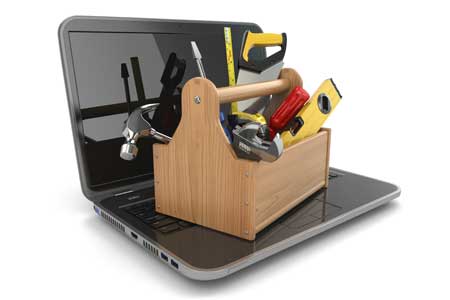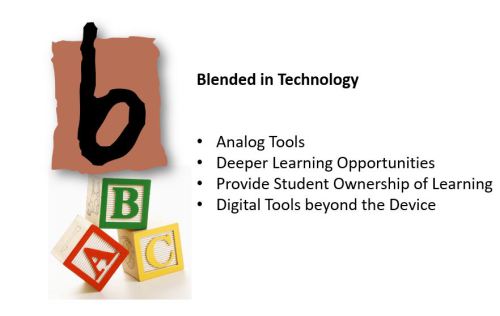B is for Blended with Technology: The ABC’s of PBL … Building Blocks to Transform Learning


Welcome to this second post in a series that promotes PBL and 21st Century Learning through the examination of Seven Building Blocks. In this second post, I would like to build the idea of the Building Block I call Blended with Technology. It may just provide a whole new look at what educational technology really is and why it is important to PBL and Deeper Learning. Before reading, please take a moment to subscribe by email or RSS, and also give me a follow… on Twitter at mjgormans. I promise you will find some wonderful information coming your way in the posts that follow…So sign up now and please pass this on with a retweet. Also, remember you can book me for a conference or your school district with workshops that are informative, engaging, and practical. Check out my Booking Page and as always… thanks so much! I am taking dates for 2018 with 2017 just about full… Mike Gorman (https://21centuryedtech.wordpress.com/)
B is for Blended with Technology: The ABC’s of PBL … Building Blocks, Elements, & Compounds of Deeper Learning by Michael Gorman at https://21centuryedtech.wordpress.com/
There are many educators that believe that Project Based Learning must be integrated with technology. In a sense this could be correct, although it depends on the definition of technology. One must remember that John Dewey was an advocate of projects long before the laptop computer, or even mainframe. He did believe that students must be doing, and this does involves something beyond sitting in a row listening to a lecture. Doing involves “using tools”, a basic definition of technology. It is for this reason that some form of analog and pre-analog technology should be blended into the learning experience. In this increasing binary world it is also important to bring in digital devices including the computer, and so many other electronic tools. At the same time the SAMR Model based on the progressive steps of substitution, augmentation, modification, and replacement integrated with Bloom’s and Webb’s DOK can truly transform the PBL experience while amplifying learning with endless possibilities. At the same time technology allows for increased student ownership of learning. It provides the opportunity for independent learning, self-regulation, formative assessment, and self regulation. Take a look at the four indicators that can blend the PBL experience.
1. Analog tools
2. Deeper Learning Opportunities
3. Provide Student Ownership of Learning
4. Digital Tools beyond the device
Analog Tools – Perhaps it is a paint bush, a carpenter’s tool, or some items from a maker’s workshop. These may be referred to as the analog tools. It is the many pre-digital age tools that can still be used to engage learning. Take a moment and watch a child play with an old fashion toy and it will become obvious there is still a world of possibilities from the pre-digital era. In fact, there are some experiences that the world of advanced technology and computers could never replace. Never forget that smell of a first crayon!
Deeper Learning Opportunities- In the 21st century classroom digital technology can also amplify the learning experience. New opportunities exist that were not possible before. The connection to the real world provides a new window for students, and the ability to bring in engaging content and activities to the classroom are endless. Technology climbing to the top of SAMR with careful integration of Webb’s Depth of Knowledge and Blooms provides students with deeper learning opportunities fostering an authentic understanding.
Provide Student Ownership of Learning – Students are no longer captive to the teacher’s lesson plan in the school walls. Learning with the internet is possible 24/7 and at any place. Students have choice of what to learn and how to learn it. Programs can be used to allow students to advance at their pace. Technology also allows for new assessment techniques allowing students to demonstrate learning in creative and innovative ways. The teacher can facilitate technology to provide this optimum learning experience.
Tools and ideas to transform education. Sign up below.
Digital Tools Beyond the Device – It must be remembered that the digital world goes beyond just the digital device whether it be a computer or tablet. There are a multitude of digital possibilities including toys, cameras, GPS units, games, robots, and electronic wonders. An investigation in the of the Makers World will not only enlighten the digital possibilities, it may also bring a new look to the analog world.
Reflection
One can only imagine what John Dewey may have done in today’s 21st century classroom. It is certain that he would have had the students helping him make those decisions. PBL has always relied on some sort of technology, no matter how basic it may have been. After all, it is the tools that allow students to do. The modern technology of today can also amplify all of the other themes found in the ABC’s of PBL. It is important for educators to understand that digital technology can help foster a blended learning experience between the classroom and its physical walls, reaching to the community and a wonderful authentic world.
Resources For Blended with Technology
- Wordle or Tagxedo or Wordclouds – Use one App really well and in multiple ways. My pick for getting teachers started was always a Word Cloud Machine such as the websites Wordle, Tagxedo, or Wordclouds (for those who experience some challenges with java). Take a moment to read my article that states 200 Ways To Use Word Clouds In The Classroom.
- Imagination Foundation Cardboard Challenge – Take a break from digital technology and devices and find a way to bring old fashion technology in the classroom such as… cardboard!
- SAMR Model – Get To Know the SAMR Model… begin with good substitution. Do not worry about what category you are in. Be willing to allow student to work ahead of your technology capabilities. Check out this SAMR Video.
- Five Ideas to go Beyond SAMR – Once you understand SAMR learn how to take learning even deeper by reading and looking at the resources in this 21centuryedtech article.
- TPACK – Take some time to discover how technology, pedagogy, and content all work together. It really is enlightening to teachers as they reflect on their teaching practice. You might even wish to watch this video.
- Common Sense Media – Are you looking for great programs and apps that really do reflect great educational pedagogy. Check out lessons and reviews at Coomon Sense. Take a moment to even view this video on Technology and Blooms.
- Integrating PBL and Technology… Keep the End in Mind – Take a look at this wonderful artcile by Suzie Boss and P21.
- Beyond the Tech Shine – Check out this article from 21centuryedtech that allows teachers to look at their standards and then figure out what verbs get their students learning and doing using technology.
- Building a Makerspace Culture to Support Standards and Learning … 10 Ideas and 16 Resources – Another article from 21centuryedtech that allows teachers to discover technology with and beyond the device in a atmoshere that allows students to do.
- Blending Technology into Project Based Learning – Bob Lentz and Sally Kingston provide a great overview of technology and PBL The article from P21 also answers the question, “What tools might fit with PBL?”.
cross-posted at 21centuryedtech.wordpress.com
Michael Gorman oversees one-to-one laptop programs and digital professional development for Southwest Allen County Schools near Fort Wayne, Indiana. He is a consultant for Discovery Education, ISTE, My Big Campus, and November Learning and is on the National Faculty for The Buck Institute for Education. His awards include district Teacher of the Year, Indiana STEM Educator of the Year and Microsoft’s 365 Global Education Hero. Read more at 21centuryedtech.wordpress.com.
